Intentional Living at Twin Oaks Community
by Linda Salisbury
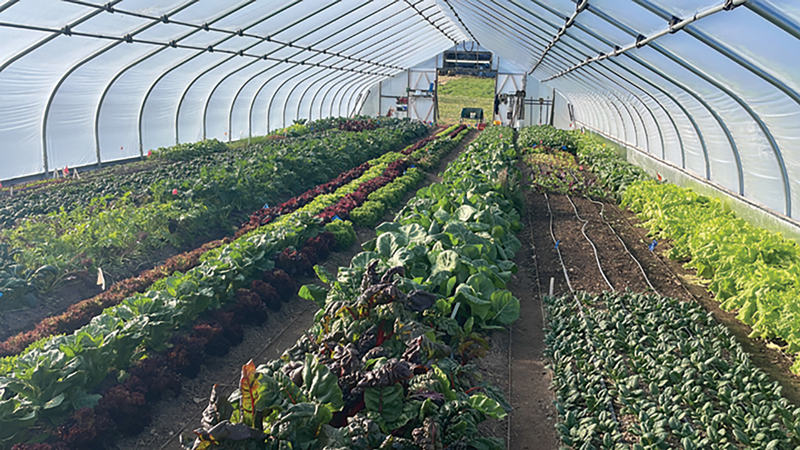
The Twin Oaks greenhouse (Hoop House) where many vegetables are grown
(photo by Raen Thornberry).
Earth, water, wind, and fire. In little more than a decade, the community of Twin Oaks – located in the fertile and forested area of Louisa County – has experienced them all and survived. Twin Oaks is located four miles from the epicenter of the 5.8 magnitude earthquake of August 23, 2011. It damaged Twin Oaks and rocked the East Coast. Then, two weeks later, this historic intentional community felt the heavy rains of Hurricane Irene but avoided damage from that storm.
The earthquake did considerable destruction not only in Twin Oaks, but also throughout Louisa County. Two schools had to be torn down, and many houses and chimneys were cracked. In the 450-acre Twin Oaks Community, pipes broke, a chimney collapsed, and there was structural damage as the contents of buildings were tossed about.
However, most devastating of all, a wind-whipped wildfire on March 24 this year did more than a million dollars in damage to the primary industrial buildings in the Twin Oaks “Emerald City.” This is where handmade rope hammocks and rope swing chairs were made and stored. Also affected were a sawmill, other buildings, and the conference pavilion. The community’s current project is planning for new businesses to replace their profitable and popular hammock business.
Twin Oaks has a long history in Louisa County. Founded in 1967, it is the oldest “intentional community” in the United States. “Our way of life has reflected our values of cooperation, sharing, egalitarianism, income-sharing, nonviolence, and ecological sustainability,” according to members. There are now about 1,500 such communities in the United States, and not all are rural.

Christian Bryant Miller, a community planner at Twin Oaks (photo by Linda Salisbury).

Raen Thornberry, a community planner in Twin Oaks (photo by Raen Thornberry).
Community members are not isolated within the grounds. Many are active in Louisa and Mineral where they shop, attend church, and participate in local schools and activities. The local community made contributions toward the more than $100,000 raised after the fire, but the vast majority of the donations came from mostly non-local former members and the families of current members.
The disasters, including the difficulties caused by the pandemic, have not caused an exodus. In fact, the number of community members has reached its capacity of 100, including about fifteen children of various ages.
Twin Oaks is best known for its hammock business. However, members are also involved with making tofu, book indexing and proofreading for authors and well-known presses, and seed distribution in association with Acorn, another nearby community. Twin Oaks members will continue to construct the wooden display stands for Acorn’s Southern Seeds.
Community members come from varied locations and for their own reasons in addition to sharing in the core values of Twin Oaks. Raen Thornberry, a community planner, moved from Berkeley, California to Twin Oaks in 2022. He said that part of Twin Oak’s appeal for him is the forest. He enjoys being among the community members and also opportunities to be alone. Thornberry also likes income sharing and the lack of individual taxes.
Ironically, Thornberry and others were at the swimming pond, a popular gathering place, on the evening of the fire. They were acknowledging the Spring Equinox by celebrating the four elements and were just invoking wind and fire when smoke from the wildfire on adjacent land filled the sky. Louisa County had earlier called a state of emergency due to high winds and dry conditions. The Louisa fires quickly consumed 200 acres.
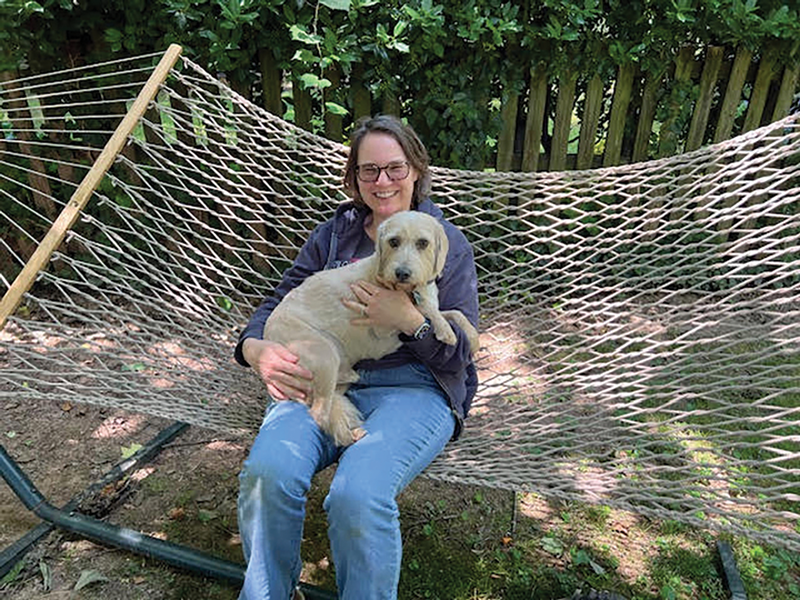
Abbie Grotke and Fritz enjoy their new hammock (photo by Denis Malloy).

Denis Malloy of Maryland relaxes in a hammock he purchased just before the Twin Oaks fire (photo by Abigail Grotke).
When fire reached Twin Oaks, it was impossible for community members to save industrial buildings like the saw mill, product inventory, equipment, and the conference pavilion. With the fire’s destruction of the industrial center, continuing the popular and profitable hammock business – the community’s primary source of income – is out of the question.
Thornberry said that as the fire came closer, “people went into survival mode.” Residents rescued valuables and fled. Fortunately, none of the seven wooden group residences were damaged despite being tucked among trees, vegetation, flowers, and herbs. Also spared were the livestock, orchards, and fields. Local fire departments soon arrived to help save the community’s facilities.
Christian Bryant Miller, also a community planner, is among the longtime members who are deeply involved in planning sessions to develop economic sustainability. Miller moved to Twin Oaks from Los Angeles in 2008. At that time, he was dropping off some things for a friend who had joined Twin Oaks. After participating in the three-week visitor program earlier that year, Miller applied and was accepted. He stayed. Like others, Miller works in areas of interest “doing what needs to be done.”
Twin Oaks’ July newsletter reported that summer planning sessions were supposed to come up with new money-making ideas. The community planned to deliberate these proposals in conference meetings. Conferences, open to the public, were already scheduled with information available on the Twin Oaks website.

The Twin Oaks TaChai building
(photo courtesy of Twin Oaks).
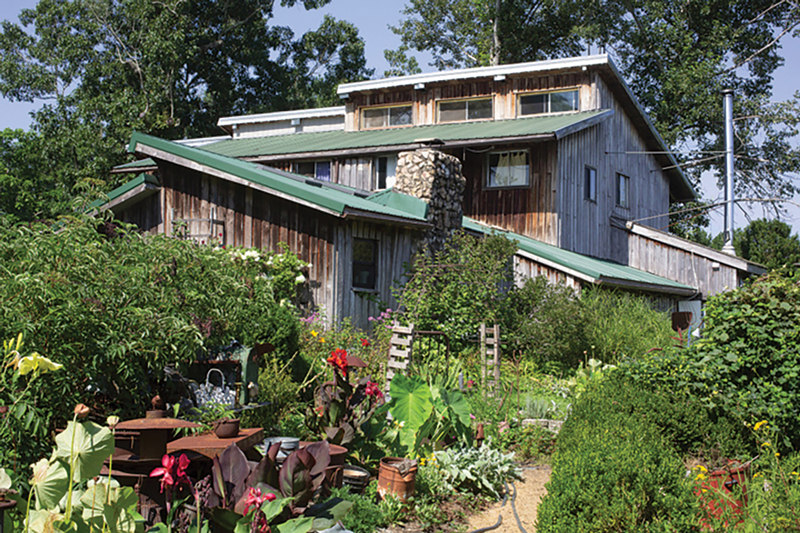
The Twin Oaks TaChai building
(photo courtesy of Twin Oaks).
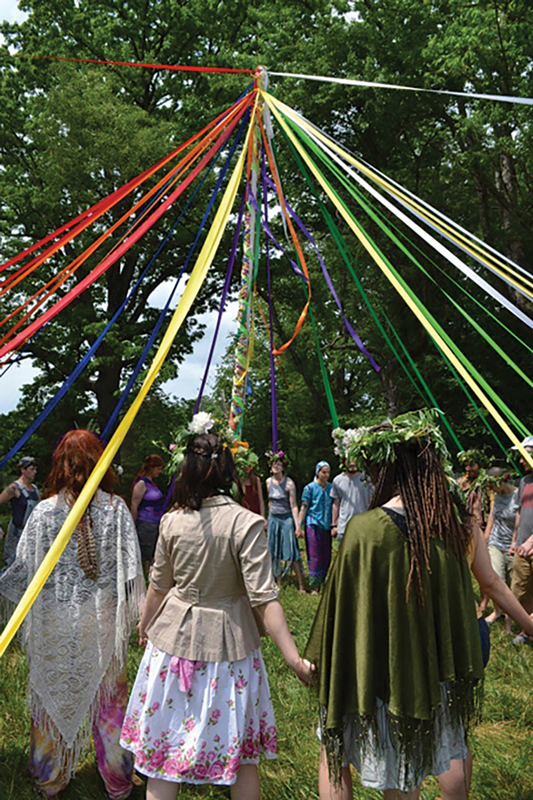
Members prepare to dance the May Pole (photo courtesy of Twin Oaks).
Miller added that members are spending extra time planning for the future as they seek to come up with new ideas. “We need to work smarter, not harder,” he said. The community is also looking at how to use materials that are salvageable.
As of July, new ideas included making pottery. A drying kiln and other pottery supplies were donated to Twin Oaks by a member’s relative. The indexing and proof-reading business might be expanded. Being part of a cooperative, tofu production will continue, as will the seed operations.
Their newsletter reported that Twin Oaks is looking at other business possibilities as well. Besides the pottery business, “proposals include renewing our hammock-chair production (but not the regular hammocks), sewing textile goods, online teaching, a tech support for local businesses, video game creation, building an eco Airbnb, and expanding of the relationship between Twin Oaks and Common Wealth Seed Growers, a seed company run by one of our members.”
Twin Oaks is as self-sufficient as possible with its businesses and agriculture. “We have six dairy cows and a small herd of cattle, which our dairy team allows to grow into old age before slaughter,” Thornberry explained. Cows are raised for milk and cheese. The flock of 50 chickens produces almost enough eggs for daily use. The community grows vegetables in the fertile fields or in a greenhouse, but as winter continues, members sometimes need to purchase additional produce elsewhere. Usually there are enough potatoes and garlic to supply the community during the non-growing season.
“We have trees of paw paws, persimmons, apples, figs, pears, mulberries, plums, and bushes of blueberries, blackberries, boomi berries, and raspberries,” Thornberry added. The rich Virginia soil is ideal for growing organic pumpkins, squash, okra, sunflowers, tomatoes, berries, Concord grapes, and peanuts. Much of the harvest is canned for later use, and fruit is also made into jam.
Life in Twin Oaks is not just about work. It has seven scheduled festivals during the year including Validation Day, which is Twin Oaks’ alternative to Valentine’s Day. Its purpose is to give everyone an opportunity to appreciate the good qualities of each other. Other impromptu celebrations occur involving dancing, games, parties, and their swimming pond with its nearby sauna.
Twin Oaks’ future is foremost in the community’s thinking. Their newsletter reported that the loss of the hammock business “has been a blow to the community in both an economic and emotional sense. While the days of the hammocks being our main source of income are long gone, the business sustained the community for many years, providing work and creating a much-loved product that made a name for ourselves.”
Lack of hammock production is also a loss for customers. Locally, hammocks and chairs had been available at the Mineral Farmer’s Market, where Twin Oaks members used to set up a tent to display and sell their colorful wares. Orders have also historically been available online.
Maryland residents Abigail Grotke and her husband, Denis Malloy, are among those who have purchased Twin Oaks’ creations. About 15 years ago, Grotke saw the tent at the Farmer’s Market. She ordered a rainbow-colored rope hammock chair for a porch swing. This year, in a house without a porch, they ordered a hammock for their backyard. It arrived a few weeks before the fire. Grotke said they ordered from Twin Oaks to support the business. The fire was sad, she lamented, adding that she was “glad we got our hammock when we did.”
As Twin Oaks members diligently work on their future plans, they are grateful for ongoing community support, including business ideas and opportunities to survive this latest calamity.
Survival is seen in the forest. The Twin Oaks newsletter reported that although the undergrowth and saplings seem permanently damaged in the area consumed by the fire, the large trees seem to be coming back. That’s good news for members, like Thornberry, who love living in the forested intentional community.
For more information about Twin Oaks, visit www.twinoaks.org or call 540-894-5126.
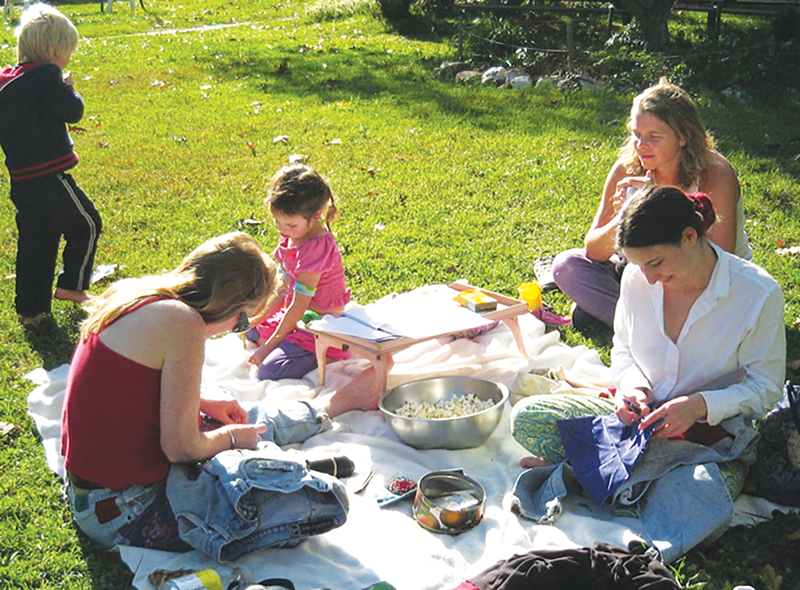
Twin Oaks residents have a mending party to repair clothes (photo courtesy of Twin Oaks).
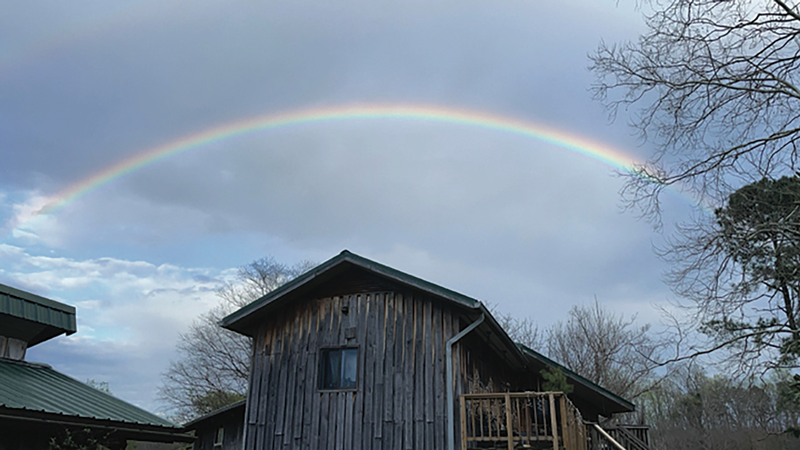
Harmony co-housing pictured under a rainbow
(photo by Raen Thornberry).
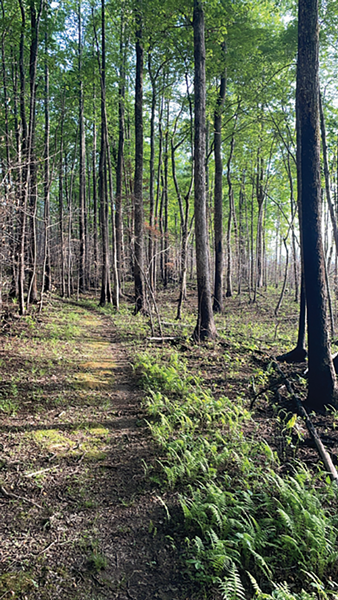
A forest path through the Twin Oaks property
(photo by Raen Thornberry).
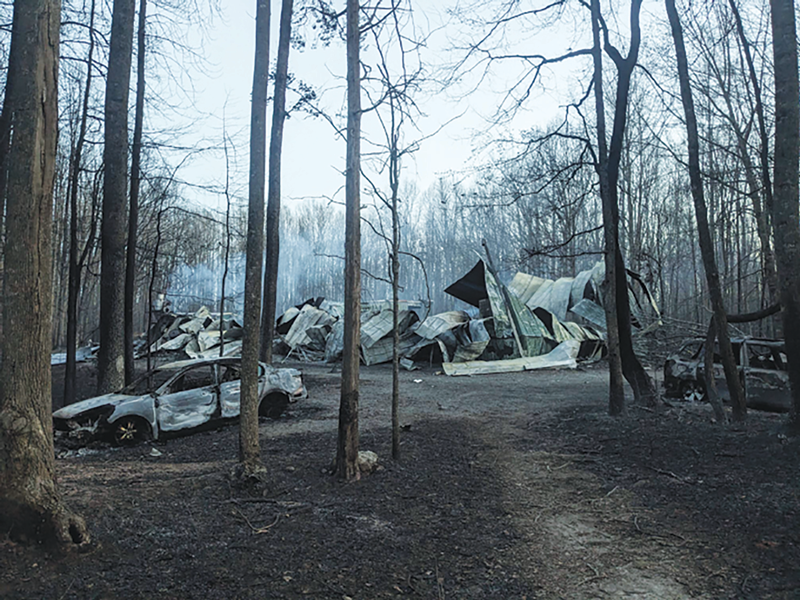
The wreckage of the Emerald City
Warehouse where inventory was stored (photo by Raen Thornberry).

